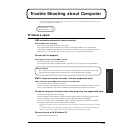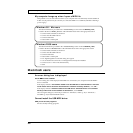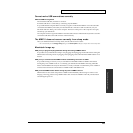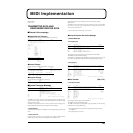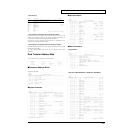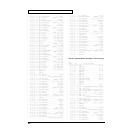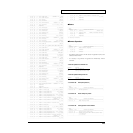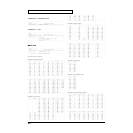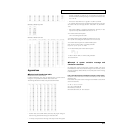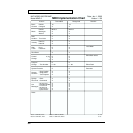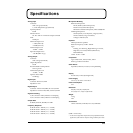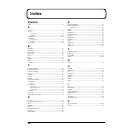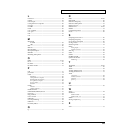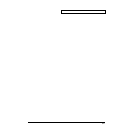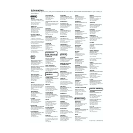
51
MIDI Implementation
| 48H — | 400 || 58H — | 1000 || 68H — | 2500 || 78H — | 6300 |
| 49H — | 422 || 59H — | 1060 || 69H | 2660 || 79H — | 6700 |
| 4AH — | 450 || 5AH — | 1120 || 6AH — | 2800 || 7AH — | 7100 |
| 4BH — | 473 || 5BH — | 1200 || 6BH — | 3000 || 7BH — | 7500 |
| 4CH — | 500 || 5CH — | 1250 || 6CH — | 3150 || 7CH — | 8000 |
| 4DH — | 530 || 5DH — | 1330 || 6DH — | 3350 || 7DH — | —— |
| 4EH — | 560 || 5EH — | 1400 || 6EH — | 3550 || 7EH — | —— |
| 4FH — | 600 || 5FH — | 1500 || 6FH — | 3760 || 7FH — | —— |
+——————————————————————————————————————————————————————————————————————————+
MIDI Data - PREAMP Type Table
+————————+————————+
| Data | TYPE |
+————————+————————+
| 00H | RED7 |
| 01H - | N1073 |
| 02H - | MANSS |
| 03H - | AVTUBE |
| 04H - | AVSOLS |
| 05H - | HHTUBE |
| 06H - | MILLHV |
| 07H - | SATUBE |
| 08H - | CSSLST |
+————————+————————+
MIDI Data - PREAMP Gain Table
+————————+————————++————————+————————++————————+————————++————————+————————+
| Data |Gain(dB)|| Data |Gain(dB)|| Data |Gain(dB)|| Data |Gain(dB)|
+————————+————————++————————+————————++————————+————————++————————+————————+
| | || 20H | — 3.2 || 40H | 0.0 || 60H | 3.2 |
| | || 21H | — 3.1 || 41H — | 0.1 || 61H — | 3.3 |
| | || 22H — | — 3.0 || 42H — | 0.2 || 62H — | 3.4 |
| | || 23H — | — 2.9 || 43H — | 0.3 || 63H — | 3.5 |
| 04H | 6.0 || 24H — | — 2.8 || 44H — | 0.4 || 64H — | 3.6 |
| 05H | 5.9 || 25H — | — 2.7 || 45H — | 0.5 || 65H — | 3.7 |
| 06H | 5.8 || 26H — | — 2.6 || 46H — | 0.6 || 66H — | 3.8 |
| 07H | 5.7 || 27H — | — 2.5 || 47H — | 0.7 || 67H — | 3.9 |
| 08H | 5.6 || 28H — | — 2.4 || 48H — | 0.8 || 68H — | 4.0 |
| 09H | 5.5 || 29H — | — 2.3 || 49H — | 0.9 || 69H — | 4.1 |
| 0AH | 5.4 || 2AH — | — 2.2 || 4AH — | 1.0 || 6AH — | 4.2 |
| 0BH | 5.3 || 2BH — | — 2.1 || 4BH — | 1.1 || 6BH — | 4.3 |
| 0CH | 5.2 || 2CH — | — 2.0 || 4CH — | 1.2 || 6CH — | 4.4 |
| 0DH | 5.1 || 2DH — | — 1.9 || 4DH — | 1.3 || 6DH — | 4.5 |
| 0EH | — 5.0 || 2EH — | — 1.8 || 4EH — | 1.4 || 6EH — | 4.6 |
| 0FH | — 4.9 || 2FH — | — 1.7 || 4FH — | 1.5 || 6FH — | 4.7 |
| 10H | — 4.8 || 30H — | — 1.6 || 50H — | 1.6 || 70H — | 4.8 |
| 11H | — 4.7 || 31H — | — 1.5 || 51H — | 1.7 || 71H — | 4.9 |
| 12H | — 4.6 || 32H — | — 1.4 || 52H — | 1.8 || 72H — | 5.0 |
| 13H | — 4.5 || 33H — | — 1.3 || 53H — | 1.9 || 73H — | 5.1 |
| 14H | — 4.4 || 34H — | — 1.2 || 54H — | 2.0 || 74H — | 5.2 |
| 15H | — 4.3 || 35H — | — 1.1 || 55H — | 2.1 || 75H — | 5.3 |
| 16H | — 4.2 || 36H — | — 1.0 || 56H — | 2.2 || 76H — | 5.4 |
| 17H | — 4.1 || 37H — | — 0.9 || 57H — | 2.3 || 77H — | 5.5 |
| 18H | — 4.0 || 38H — | — 0.8 || 58H — | 2.4 || 78H — | 5.6 |
| 19H | — 3.9 || 39H — | — 0.7 || 59H — | 2.5 || 79H — | 5.7 |
| 1AH | — 3.8 || 3AH — | — 0.6 || 5AH — | 2.6 || 7AH — | 5.8 |
| 1BH | — 3.7 || 3BH — | — 0.5 || 5BH — | 2.7 || 7BH — | 5.9 |
| 1CH | — 3.6 || 3CH — | — 0.4 || 5CH — | 2.8 || 7CH — | 6.0 |
| 1DH | — 3.5 || 3DH — | — 0.3 || 5DH — | 2.9 || | |
| 1EH | — 3.4 || 3EH — | — 0.2 || 5EH — | 3.0 || | |
| 1FH | — 3.3 || 3FH — | — 0.1 || 5FH — | 3.1 || | |
+————————+————————++————————+————————++————————+————————++————————+————————+
Appendices
●Decimal and Hexadecimal table
(Hexadecimal number is shown with H.)
In MIDI documentation, data values and addresses/sizes of system exclusive
messages etc. are expressed as hexadecimal values for each 7 bits.
The following table shows how these correspond to decimal numbers.
+——————+——————++——————+——————++——————+——————++——————+——————+
| Deci | Hexa || Deci | Hexa || Deci | Hexa || Deci | Hexa |
+——————+——————++——————+——————++——————+——————++——————+——————+
| 0 | 00H || 32 | 20H || 64 | 40H || 96 | 60H |
| 1 | 01H || 33 | 21H || 65 | 41H || 97 | 61H |
| 2 | 02H || 34 | 22H || 66 | 42H || 98 | 62H |
| 3 | 03H || 35 | 23H || 67 | 43H || 99 | 63H |
| 4 | 04H || 36 | 24H || 68 | 44H || 100 | 64H |
| 5 | 05H || 37 | 25H || 69 | 45H || 101 | 65H |
| 6 | 06H || 38 | 26H || 70 | 46H || 102 | 66H |
| 7 | 07H || 39 | 27H || 71 | 47H || 103 | 67H |
| 8 | 08H || 40 | 28H || 72 | 48H || 104 | 68H |
| 9 | 09H || 41 | 29H || 73 | 49H || 105 | 69H |
| 10 | 0AH || 42 | 2AH || 74 | 4AH || 106 | 6AH |
| 11 | 0BH || 43 | 2BH || 75 | 4BH || 107 | 6BH |
| 12 | 0CH || 44 | 2CH || 76 | 4CH || 108 | 6CH |
| 13 | 0DH || 45 | 2DH || 77 | 4DH || 109 | 6DH |
| 14 | 0EH || 46 | 2EH || 78 | 4EH || 110 | 6EH |
| 15 | 0FH || 47 | 2FH || 79 | 4FH || 111 | 6FH |
| 16 | 10H || 48 | 30H || 80 | 50H || 112 | 70H |
| 17 | 11H || 49 | 31H || 81 | 51H || 113 | 71H |
| 18 | 12H || 50 | 32H || 82 | 52H || 114 | 72H |
| 19 | 13H || 51 | 33H || 83 | 53H || 115 | 73H |
| 20 | 14H || 52 | 34H || 84 | 54H || 116 | 74H |
| 21 | 15H || 53 | 35H || 85 | 55H || 117 | 75H |
| 22 | 16H || 54 | 36H || 86 | 56H || 118 | 76H |
| 23 | 17H || 55 | 37H || 87 | 57H || 119 | 77H |
| 24 | 18H || 56 | 38H || 88 | 58H || 120 | 78H |
| 25 | 19H || 57 | 39H || 89 | 59H || 121 | 79H |
| 26 | 1AH || 58 | 3AH || 90 | 5AH || 122 | 7AH |
| 27 | 1BH || 59 | 3BH || 91 | 5BH || 123 | 7BH |
| 28 | 1CH || 60 | 3CH || 92 | 5CH || 124 | 7CH |
| 29 | 1DH || 61 | 3DH || 93 | 5DH || 125 | 7DH |
| 30 | 1EH || 62 | 3EH || 94 | 5EH || 126 | 7EH |
| 31 | 1FH || 63 | 3FH || 95 | 5FH || 127 | 7FH |
+——————+——————++——————+——————++——————+——————++——————+——————+
* Decimal values such as MIDI channel, bank select, and program change are
listed as one (1) greater than the values given in the above table.
* A 7-bit byte can express data in the range of 128 steps. For data where greater
precision is required, we must use two or more bytes. For example, two
hexadecimal numbers aa bbH expressing two 7-bit bytes would indicate a value
of aa x 128 + bb.
* In the case of values which have a ± sign, 00H = -64, 40H = ±0, and 7FH
= +63, so that the decimal expression would be 64 less than the value given in the
above chart. In the case of two types, 00 00H = -8192, 40 00H = ±0, and 7F 7FH =
+8191.
* Data marked “nibbled” is expressed in hexadecimal in 4-bit units. A value
expressed as a 2-byte nibble 0a 0bH has the value of a x 16 + b.
<Ex.1> What is 5AH in decimal system?
5AH = 90 according to the above table.
<Ex.2>What in decimal system is 12034H in hexadecimal of every 7 bit?
12H = 18, 34H = 52 according to the above table. So 18 x 128 + 52 = 2356.
<Ex.3> What in decimal system is 0A 03 09 0D in nibble system?
0AH = 10, 03H = 3, 09H = 9, 0DH = 13 according to the table.
So ((10 x 16 + 3) x 16 + 9) x 16 + 13 = 41885.
<Ex. 4> What in nibble system is 1258 in decimal system?
____
16)1258
16) 78 ... 10
16) 4 ... 14
0 ... 4
0 = 00H, 4 = 04H, 14 = 0EH, 10 = 0AH According to the table.
So it is 00 04 0E 0AH.
●Example of system exclusive message and
Checksum calculation
On Roland system exclusive message (DT1), checksum is added at the end of
transmitted data (in front of F7) to check the message is received correctly. Value of
checksum is defined by address and data (or size) of the system exclusive message
to be transmitted.
How to calculate checksum (Hexadecimal number is shown with H.)
Checksum is a value which lower 7 bit of the sum of address, size and checksum
itself turns to be 0.
If the address of the system exclusive message to be transmitted is aa bb ccH and
data or size is dd ee ffH,
aa + bb + cc + dd + ee + ff = sum
sum / 128 = quotient and odd
When odd is 0, 0 = checksum
When odd is other than 0, 128 - odd = checksum



